Basic Obedience Training for Puppies: Training a puppy is one of the most important steps in raising a happy, well-behaved dog. Puppies are curious and eager to learn. It’s the perfect time to teach them good habits. Basic obedience training for puppies ensures they grow into confident, well-mannered companions.
Teaching commands like “sit,” “stay,” and “come” improves your puppy’s behavior. It also strengthens your bond. Obedience training builds trust between you and your dog. It creates a lasting, positive relationship. Early training helps prevent issues like excessive barking, chewing, and leash pulling.
This guide will walk you through everything you need to know about puppy training basics. From the 5 basic commands for dogs to tips for using dog training supplies, we’ll cover it all. These techniques are simple, effective, and fun for you and your dog. Use them to teach a new puppy or help an older dog.
Also Read
Start early and be consistent. You’ll see how fast your puppy learns. Let’s explore the best ways to make training a rewarding experience for you and your furry friend.
Why Obedience Training Matters

Training a puppy is more than teaching commands. It builds a lifetime of good behavior and a strong bond with its owner. Puppies are eager to learn. Early, basic obedience training will make them well-mannered, confident dogs.
The Benefits of Obedience Training
- Improved Behavior: Early training prevents destructive habits, such as chewing or excessive barking.
- Safety: Commands like “stay” and “come” protect your puppy in potentially dangerous situations.
- Stronger Bond: Regular training builds trust and strengthens the connection between you and your dog.
- Mental Stimulation: Learning commands engages your puppy’s mind, reducing boredom and related issues.
Stages of Obedience Training
Training your puppy progresses through several stages:
- Introduction to Commands: Start with basic cues like “sit” and “stay.”
- Socialization: Teach them to interact calmly with people and other animals.
- Advanced Training: Once you master basic commands, move on to leash training or off-leash control.
Tools That Enhance Training
| Tool | Purpose |
|---|---|
| Clicker | Marks correct behavior instantly |
| Training Leash | Provides control and teaches proper walking |
| Treat Pouch | Keeps rewards handy for immediate reinforcement |
| Puzzle Toys | Offers mental stimulation during breaks |
How Training Improves Relationships
Puppies that undergo obedience training are more adaptable and cooperative. It makes life easier and strengthens your bond through understanding.
External Link
For more information, visit ASPCA Puppy Training Guide.
Essential Tools for Puppy Training
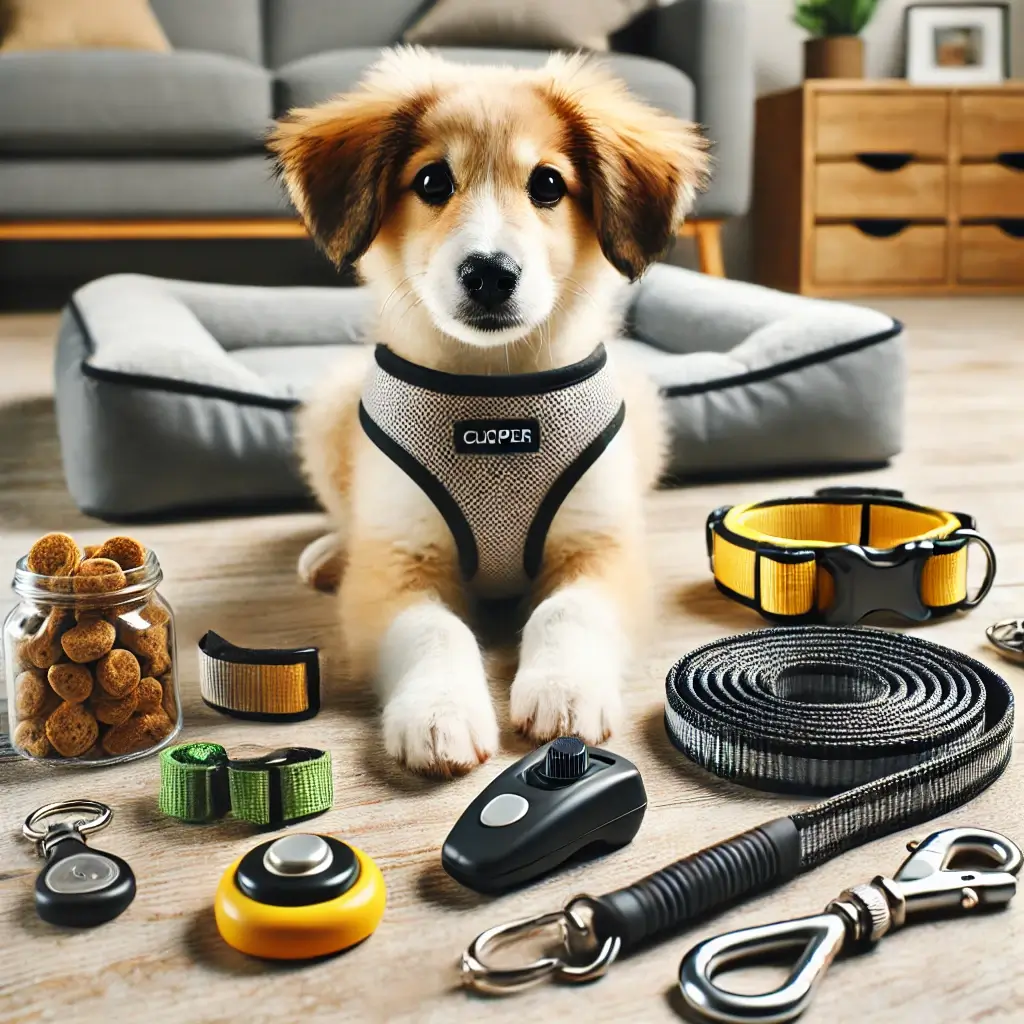
The right tools can greatly improve your puppy’s training. These tools make sessions more effective, engaging, and fun for both you and your furry friend. Below is a detailed guide to the most essential dog training supplies and how they contribute to successful training.
1. Clicker
- Purpose: A clicker is a small device that makes a clicking sound to mark the exact moment your puppy performs a desired behavior.
- Why It Works: It provides immediate feedback, helping your puppy associate the action with a reward.
- Tips for Use:
- Pair the click with a treat to reinforce positive behaviors.
- Use the clicker consistently during training sessions.
2. Leash and Harness
- Purpose: Leashes and harnesses ensure control during training and prevent accidents.
- Why It Works: These tools teach proper leash manners and help with commands like “heel” or “stay.”
- Tips for Use:
- Choose a harness that fits snugly without causing discomfort.
- Use a standard leash instead of a retractable one for better control.
3. Treat Pouch
- Purpose: Keeps treats within reach, allowing for quick rewards.
- Why It Works: Immediate reinforcement is key to effective training.
- Tips for Use:
- Stock the pouch with small, high-value treats your puppy loves.
- Clean the pouch regularly to avoid lingering food smells.
4. Training Pads or Mats
- Purpose: A designated space for training commands like “stay” or “place.”
- Why It Works: Pads create a consistent environment, helping puppies to focus on tasks.
- Tips for Use:
- Use verbal commands like “go to your mat” to associate the pad with relaxation.
- Reward your puppy for staying on the mat during sessions.
5. Puzzle Toys
- Purpose: Engage your puppy’s mind during breaks or as part of enrichment training.
- Why It Works: These toys reduce boredom and destructive behaviors.
- Tips for Use:
- Introduce toys slowly to ensure your puppy stays interested.
- Rotate toys to maintain novelty.
Comparison Table: Essential Tools
| Tool | Purpose | Tips for Effectiveness |
|---|---|---|
| Clicker | Immediate feedback for desired behaviors | Pair with treats consistently |
| Leash & Harness | Control and safety during training | Ensure proper fit |
| Treat Pouch | Quick access to rewards | Use small, high-value treats |
| Training Pads | Create a consistent training space | Associate with commands like “stay” |
| Puzzle Toys | Mental stimulation and enrichment | Rotate toys for ongoing engagement |
Affiliate Links
External Resource
Learn more about puppy training essentials at AKC Puppy Training Tools.
Step-by-Step Guide to Basic Obedience Training
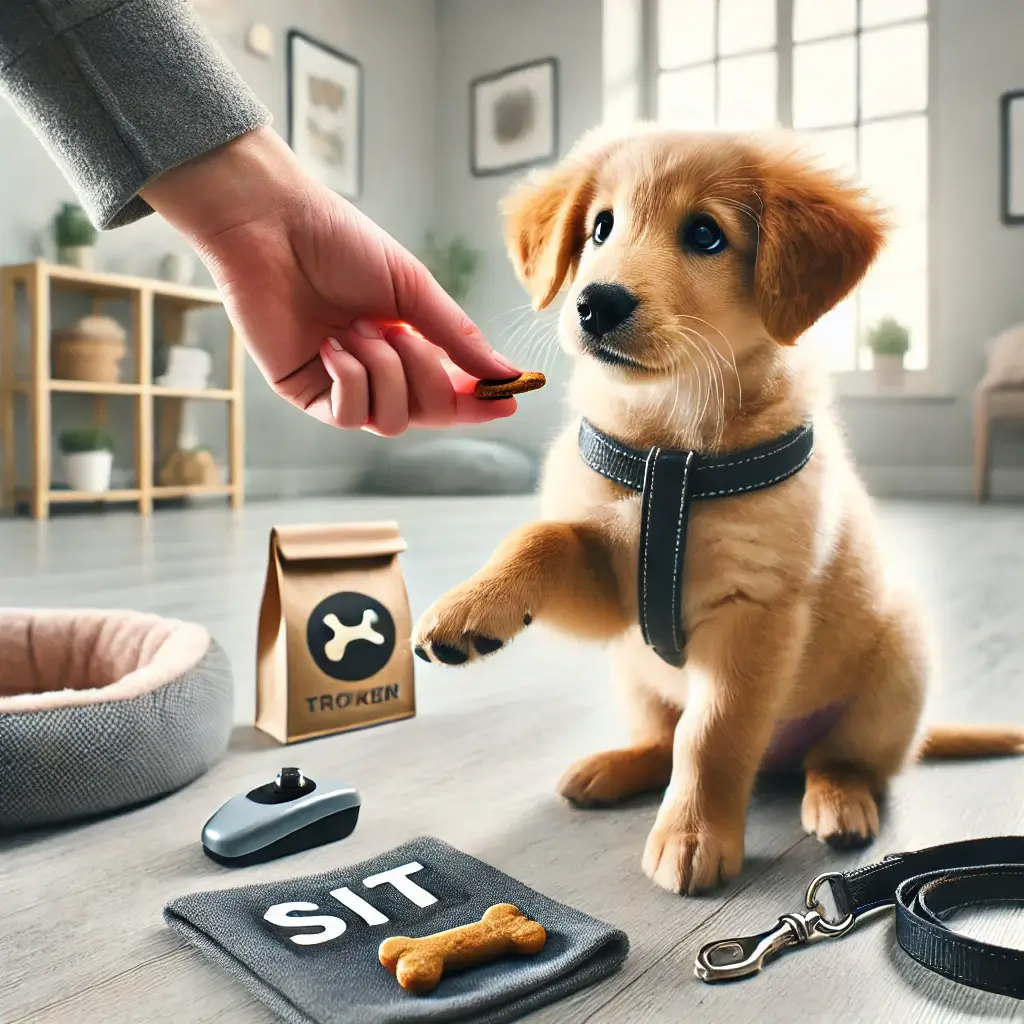
Training your puppy to follow basic commands is key to a well-mannered companion. This guide will help you teach your puppy. It will build trust and communication.
1. Start with the Basics: “Sit”
- Why It’s Important: “Sit” is one of the easiest commands to teach and helps establish control.
- How to Teach It:
- Hold a treat close to your puppy’s nose.
- Slowly move your hand upward, causing your puppy’s head to follow.
- As their bottoms touch the ground, say “Sit” and reward them with the treat and praise.
- Tips: Practice this in short, focused sessions to avoid overwhelming your puppy.
2. Progress to “Stay”
- Why It’s Important: “Stay” helps with safety and impulse control.
- How to Teach It:
- Ask your puppy to sit.
- Hold your palm out toward them and say, “Stay.”
- Take a step back. If they remain still, reward them immediately.
- Gradually increase the distance and duration of the stay.
- Tips: Use a clicker to mark success and reward promptly.
3. Recall Command: “Come”
- Why It’s Important: A reliable recall keeps your puppy safe and responsive.
- How to Teach It:
- Attach a long leash to your puppy.
- Say “Come” in an excited tone and gently pull the leash.
- Reward your puppy with treats and affection when they approach.
- Tips: Practice in distraction-free areas before advancing to busy environments.
4. Introduce “Leave It”
- Why It’s Important: Prevents your puppy from picking up harmful objects.
- How to Teach It:
- Place a treat in your closed fist.
- Allow your puppy to sniff but not take it.
- Say “Leave it” and wait until they move back.
- Reward them with a different treat or praise.
- Tips: Consistency is key; always use the same phrase.
5. Use Positive Reinforcement
- Why It’s Important: Encourages good behavior and builds confidence.
- How to Use It:
- Reward immediately after a desired behavior with treats, toys, or praise.
- Avoid punishment; instead, redirect negative behavior to a positive action.
Visual Aid: Puppy Training Progress
| Command | Average Time to Learn | Success Rate with Consistency |
|---|---|---|
| Sit | 1-2 Days | 90% |
| Stay | 5-7 Days | 85% |
| Come | 3-5 Days | 80% |
| Leave It | 4-6 Days | 75% |
Common Challenges
- Short Attention Spans: Puppies may lose focus quickly. Keep sessions short (5–10 minutes).
- Inconsistent Commands: Use the same words and gestures to avoid confusion.
- Distractions: Start training in a quiet space and gradually introduce distractions.
Affiliate Links
External Resource
For more training tips, visit ASPCA Puppy Training Essentials.
Common Mistakes in Puppy Training

Training a puppy can be rewarding. But, common errors can slow progress. They can also frustrate both the owner and the dog. Spotting these mistakes early makes puppy training effective and fun.
1. Inconsistency in Commands
- Why It’s a Problem: Using different words or gestures for the same command confuses puppies. It makes it harder for them to understand what is expected.
- Solution: Stick to one word or gesture for each command. For example, always use “Come” instead of alternating between “Come here” and “Get over here.”
2. Overusing Treats
- Why It’s a Problem: Relying solely on treats can lead to a puppy that only responds when food is involved.
- Solution: Gradually phase out treats and replace them with praise, toys, or affection as rewards.
3. Long Training Sessions
- Why It’s a Problem: Puppies have short attention spans and may become bored or distracted during lengthy sessions.
- Solution: Keep training sessions brief—5 to 10 minutes—and focus on one or two commands at a time.
4. Skipping Socialization
- Why It’s a Problem: Lack of exposure to different people, animals, and environments can lead to fear or aggression later in life.
- Gradually and positively introduce your puppy to new places and people.
5. Punishment-Based Training
- Why It’s a Problem: Punishment can create fear, anxiety, and a lack of trust between you and your puppy.
- Solution: Use positive reinforcement to encourage good behavior. Don’t focus on punishing mistakes.
Visual Representation: Common Puppy Training Mistakes
| Mistake | Impact on Puppy | Corrective Action |
|---|---|---|
| Inconsistent Commands | Confusion, slower learning | Use one consistent word or signal |
| Overusing Treats | Dependency on food rewards | Transition to praise or toys gradually |
| Long Sessions | Loss of focus and engagement | Limit to 5-10 minutes |
| Skipping Socialization | Fear or aggression later | Gradually expose to new experiences |
| Punishment-Based Methods | Anxiety, fear of trainer | Emphasize positive reinforcement |
Tips for Avoiding These Mistakes
- Plan Ahead: Decide on the commands and rewards before starting training.
- Stay Patient: Puppies need time to learn; avoid frustration.
- Create a Routine: Consistency helps puppies feel secure and understand expectations.
Affiliate Recommendations
External Link
Explore more on avoiding training mistakes at ASPCA Puppy Training Guide.
Advanced Obedience Techniques
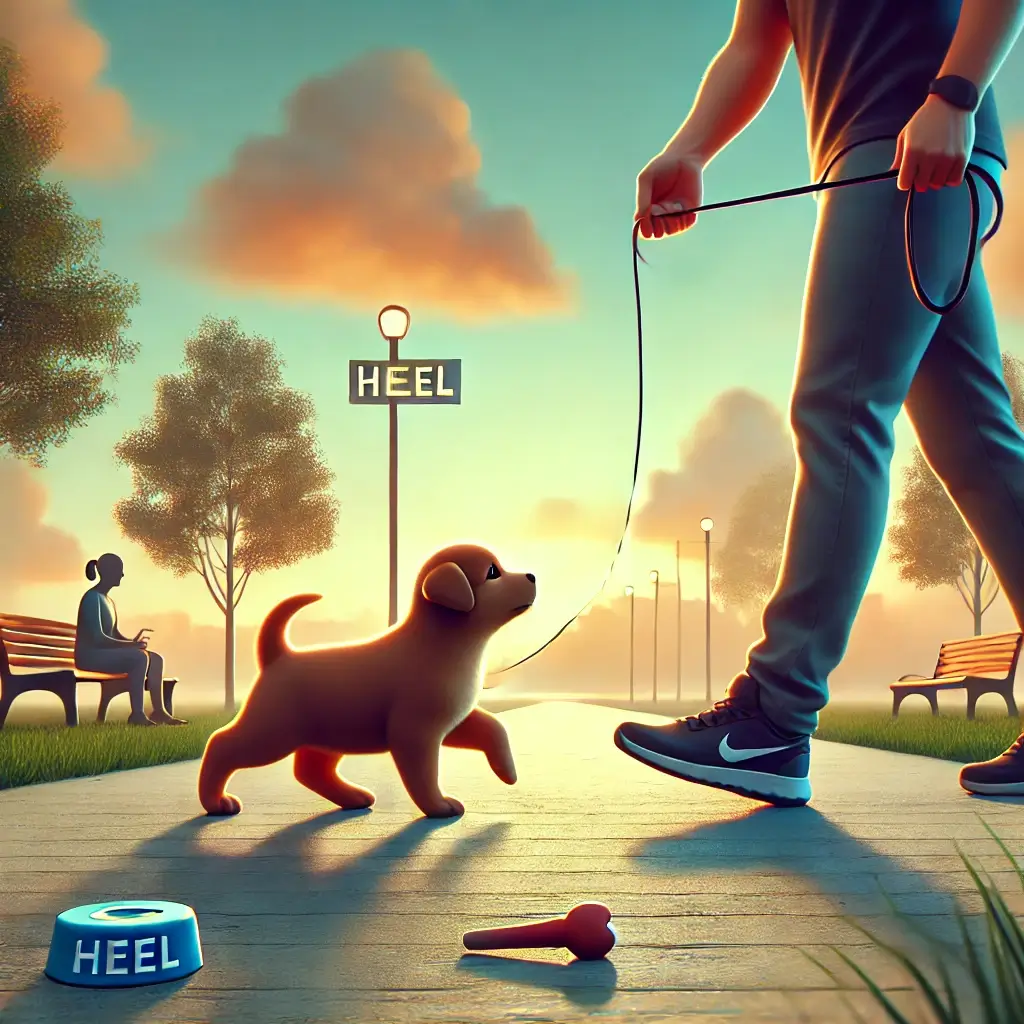
Once your puppy has mastered the basics, advance their training. It will boost their confidence and responsiveness. Advanced obedience techniques help your puppy handle complex commands and tough situations. These techniques will strengthen your bond with your pet. They will also prepare your pet for off-leash control and public behavior.
1. Teaching the “Heel” command
- Why It’s Important: The “heel” command ensures your dog walks calmly at your side without pulling on the leash.
- How to Teach It:
- Start with your puppy on a leash in a quiet area.
- Hold a treat close to your puppy’s nose and say “Heel.”
- Take a few steps forward while keeping the treat at your side.
- Reward them when they stay by your side without pulling.
- Tips: Practice in different environments to generalize the behavior.
2. Advanced Recall (“Come”)
- Why It’s Important: A reliable recall command is crucial for off-leash safety and preventing accidents.
- How to Teach It:
- Use a long training leash in an open area.
- Say “Come” in an enthusiastic tone while backing up.
- Reward your puppy when it runs toward you immediately.
- Gradually remove the leash as they master the command.
- Tips: Use high-value rewards like favorite treats or toys to encourage quick responses.
3. Training the “Wait” Command
- Why It’s Important: The “wait” command prevents your dog from rushing out of doors or into unsafe areas.
- How to Teach It:
- Ask your puppy to sit near the door.
- Open the door slightly while saying, “Wait.”
- Reward them if they stay seated, and close the door if they move.
- Gradually increase the duration before allowing them to proceed.
- Tips: Combine this command with “Stay” for more control in public spaces.
4. Off-Leash Control
- Why It’s Important: Off-leash training allows freedom while ensuring your dog remains responsive to commands.
- How to Teach It:
- Begin in a fenced area to ensure safety.
- Practice basic commands like “Sit,” “Stay,” and “Come” without the leash.
- Gradually introduce distractions to test their focus.
- Tips: Always carry a treat pouch for immediate rewards during training.
Visual Chart: Advanced Training Goals
| Command | Benefits | Time to Master |
|---|---|---|
| Heel | Safe, controlled walks | 1–2 Weeks |
| Advanced Recall | Prevents accidents in open spaces | 2–3 Weeks |
| Wait | Reduces impulsive behavior | 1 Week |
| Off-Leash Control | Ensures freedom with safety | 3–4 Weeks |
Common Challenges in Advanced Training
- Distractions: Increase gradually to prevent overwhelm.
- Inconsistent Practice: Schedule daily sessions to reinforce commands.
- Impatience: Progress takes time; celebrate small wins.
Affiliate Links
External Resource
For detailed techniques, visit American Kennel Club Training Guide.
Cost of Puppy Training: DIY vs. Professional Help
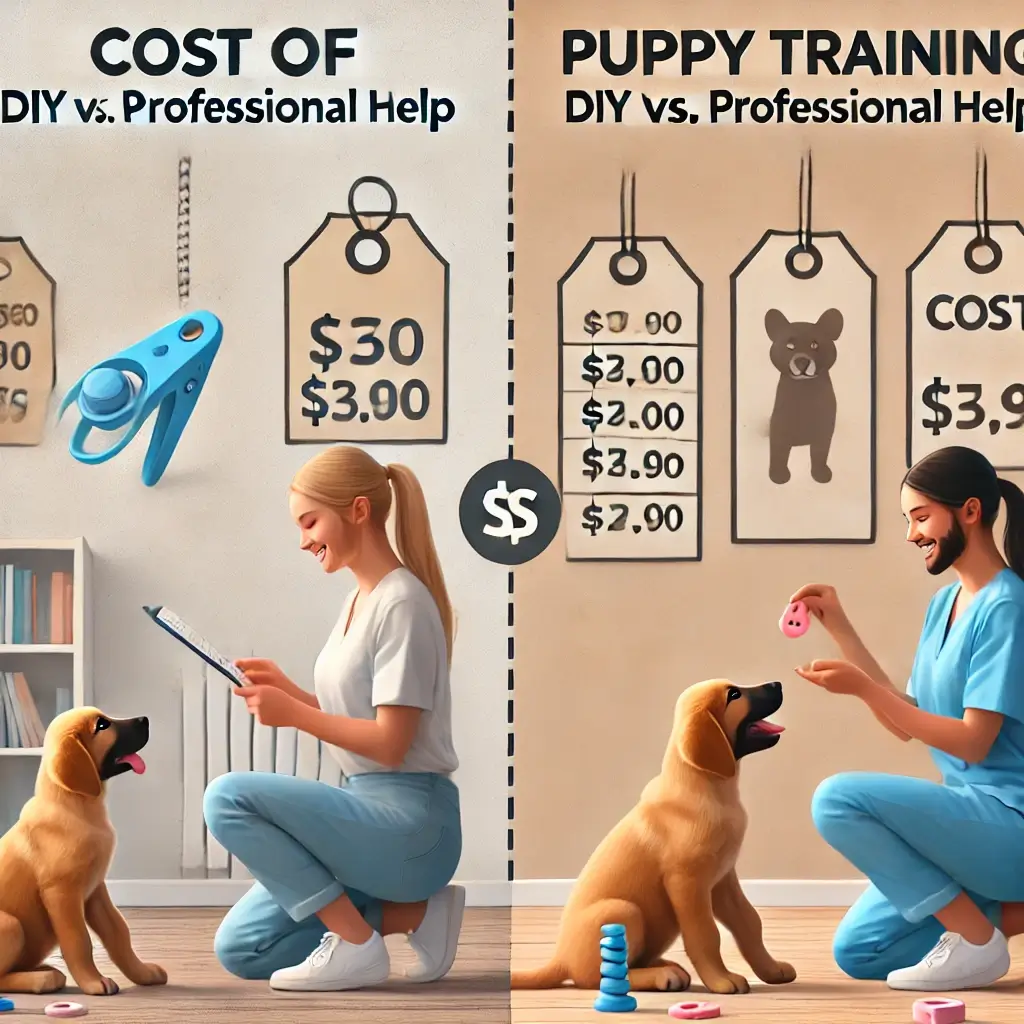
Training your puppy is an investment in its well-being and your peace of mind. It’s crucial to know the costs, whether you train yourself or hire a pro. This section compares the costs of both approaches to help you decide.
1. DIY Puppy Training
- Overview: DIY training involves teaching your puppy at home. Use books, videos, or training aids.
- Costs:
- Training Tools (Clicker, Leash, Treats): $20–$50.
- Online Courses or PDFs: Free to $100.
- Time Investment: A few hours weekly over several months.
- Advantages:
- Affordable and flexible.
- Strengthen your bond with your puppy through direct interaction.
- Challenges:
- Requires patience and consistency.
- Limited expertise in addressing complex behaviors.
2. Professional Training
- Overview: Professional training includes group classes, private sessions, or boarding schools.
- Costs:
- Group Classes: $100–$300 for 4–6 weeks.
- Private Lessons: $50–$150 per session.
- Boarding Programs: $1,000–$3,000 for intensive training.
- Advantages:
- Access to expert trainers.
- Structured curriculum tailored to your puppy’s needs.
- Challenges:
- Expensive compared to DIY methods.
- Less frequent interaction with your puppy during boarding programs.
Comparison Chart: DIY vs. Professional Training
| Feature | DIY Training | Professional Training |
|---|---|---|
| Cost | $20–$150 | $100–$3,000 |
| Time Commitment | High | Moderate |
| Trainer Expertise | Limited to personal research | High |
| Customization | Fully customizable | Tailored by trainer |
| Bond Strengthening | High | Moderate |
Finding the Right Balance
- Combination Approach: Many pet owners choose group classes to learn the basics. Then, they train at home for advanced commands.
- Free Resources: Access free training articles by pet type or download a puppy training basics PDF to supplement your knowledge.
Tips for Saving Money
- Use affordable tools like clickers and treat pouches.
- Watch free video tutorials or enroll in budget-friendly online courses.
- Join local group classes instead of private lessons for cost-efficiency.
Affiliate Recommendations
External Link
Learn more about training costs and methods at ASPCA Puppy Training Guide.
Optimal Training Session Durations for Puppies
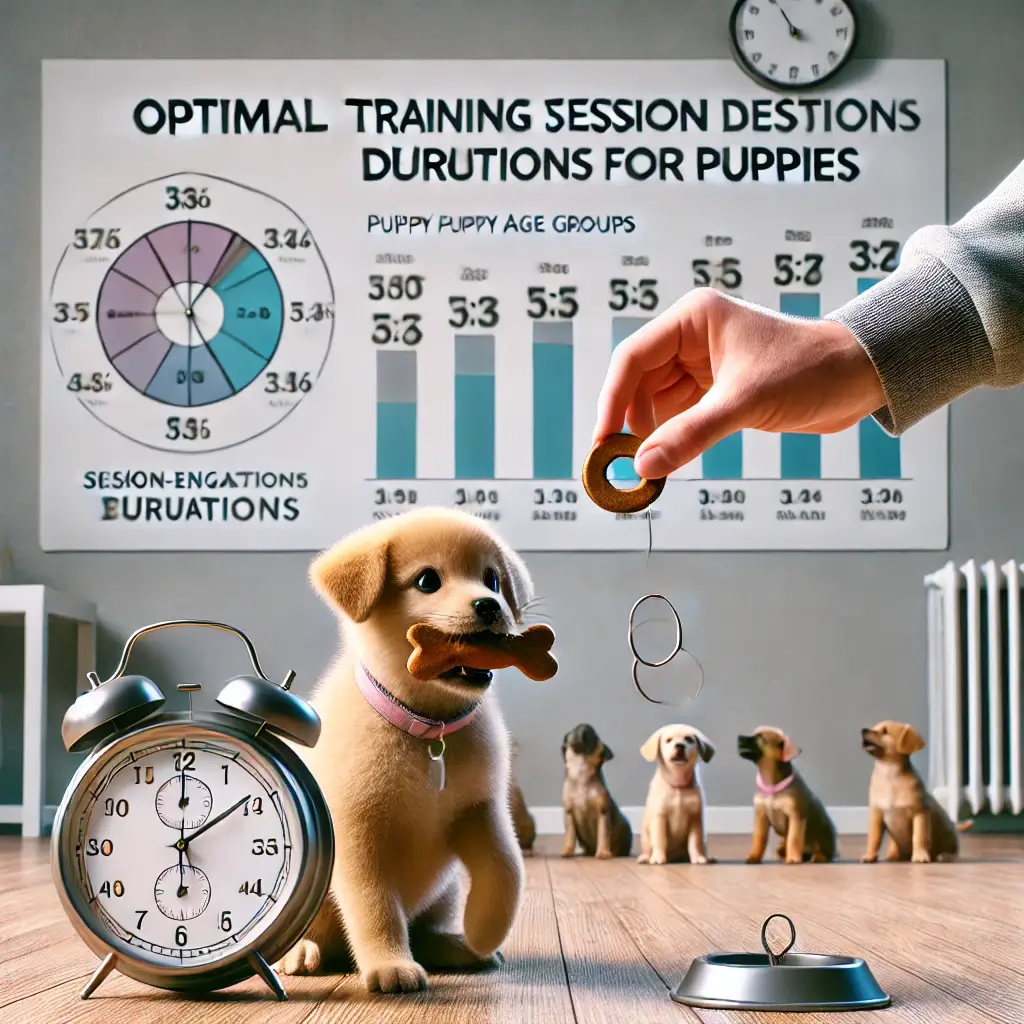
Training sessions are vital for teaching your puppy commands and behaviors. But their success often depends on the sessions’ length and structure. Puppies have short attention spans. So, keep training sessions short. This will help them focus and enjoy learning.
1. Why Training Session Durations Matter
- Puppies are like young children; they get distracted or tired in a short time.
- Short, focused sessions ensure that learning is effective without overwhelming your puppy.
- Regular, manageable durations help establish a routine and reinforce positive behavior.
2. Ideal Training Session Lengths
| Age of Puppy | Session Duration | Frequency |
|---|---|---|
| 8–12 weeks | 3–5 minutes per session | 3–5 times per day |
| 3–6 months | 5–10 minutes per session | 2–3 times per day |
| 6 months and older | 10–15 minutes per session | 1–2 times per day |
3. Break Sessions into Small Goals
- Focus on teaching one or two commands per session, such as “sit” or “stay.”
- Start with simple tasks. As your puppy gains confidence, progress to more complex ones.
4. Tips for Maximizing Training Effectiveness
- Choose the Right Time: Train your puppy when it is calm and attentive. Avoid training when it is too energetic or tired.
- Use Positive Reinforcement: Reward good behavior with treats, toys, or praise immediately after a correct action.
- Incorporate Play Breaks: Allow your puppy to play between sessions to release energy and reset their focus.
- End on a Positive Note: Always finish sessions with a success, even if it’s a simple command like “sit.”
5. Adjusting Durations Based on Progress
- Slow Learners: If your puppy struggles with commands, shorten the sessions and increase the repetitions.
- Quick Learners: Increase session lengths over time. Then, add advanced commands to challenge them.
6. Common Mistakes to Avoid
- Overtraining: Long or repetitive sessions can lead to frustration and decreased interest.
- Inconsistent Timing: Irregular sessions disrupt the training routine and slow progress.
- Neglecting Breaks: Training without breaks can result in a tired and uncooperative puppy.
Example Daily Training Schedule for an 8–12 Week Old Puppy
| Time | Activity |
|---|---|
| 8:00 AM | 3-minute session: Teaching “sit” |
| 11:00 AM | 3-minute session: Teaching “stay” |
| 2:00 PM | 3-minute session: Practicing recall (“come”) |
| 5:00 PM | 3-minute session: Introducing “leave it” |
| 8:00 PM | 3-minute session: Reviewing all commands |
How to Avoid Puppy Training Errors
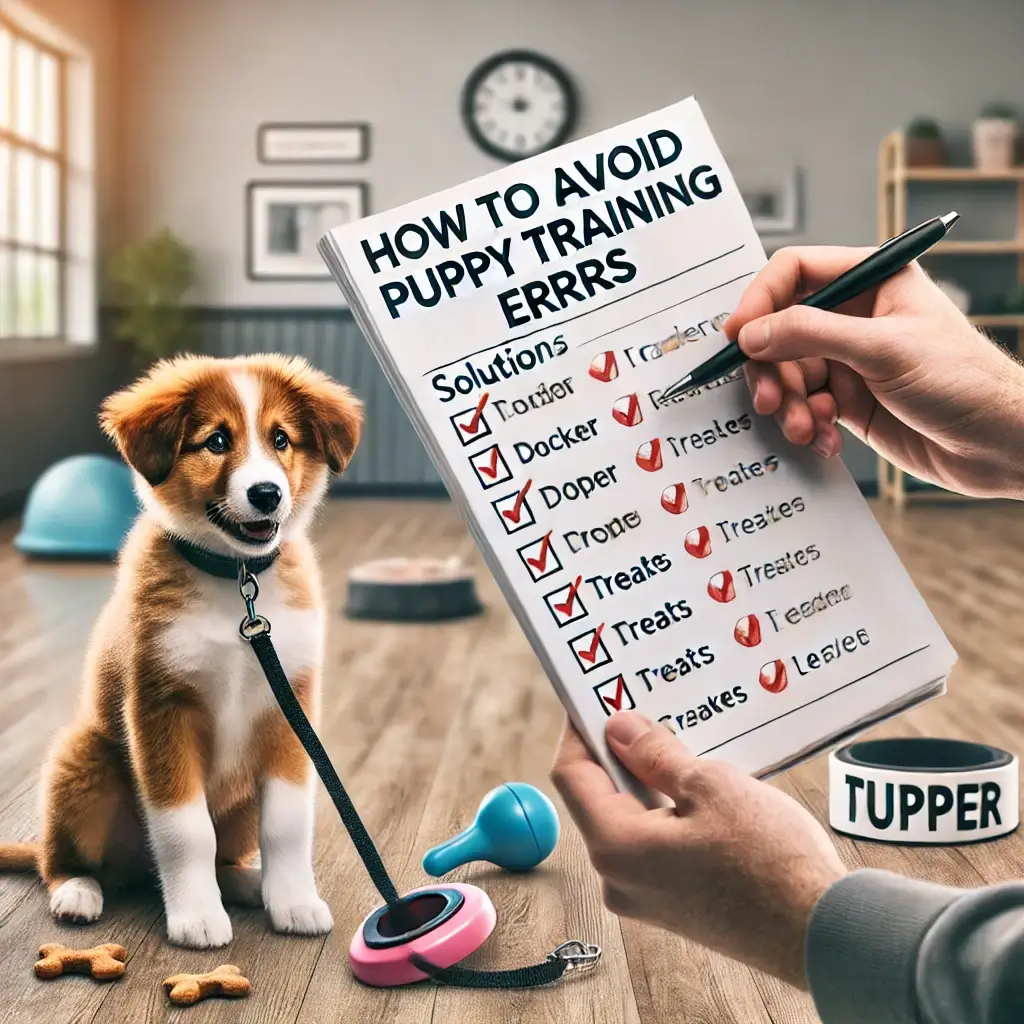
Training your puppy can be exciting and rewarding. But, common mistakes can hinder progress and confuse you and your pup. Avoiding these errors will ensure a smoother, more enjoyable training experience.
1. Start Early, But Not Too Early
- The Error: Starting formal training before your puppy reaches developmental readiness can lead to frustration.
- How to Avoid:
- Begin with simple commands like “sit” or “stay” at around 8–12 weeks of age.
- Focus on socialization and basic manners before progressing to complex commands.
2. Be Consistent
- The Error: Using inconsistent commands or signals confuses your puppy.
- How to Avoid:
- Use the same word or gesture for each command. For example, always say “come” instead of alternating between “come here” and “get over there.”
- Ensure all family members are consistent with commands and training techniques.
3. Keep Sessions Short and engaging
- The Error: Overtraining your puppy can cause boredom and loss of focus.
- How to Avoid:
- Limit sessions to 3–5 minutes for younger puppies and 10–15 minutes for older ones.
- Incorporate play breaks to keep training fun and engaging.
4. Use Positive Reinforcement
- The Error: Punishing mistakes can create fear and hinder trust.
- How to Avoid:
- Reward desired behaviors with treats, praise, or toys immediately after they occur.
- Redirect unwanted behaviors rather than punishing them. For example, if your puppy is chewing a shoe, replace it with a chew toy.
5. Avoid Training in Distracting Environments
- The Error: Starting training in noisy or unfamiliar places can overwhelm your puppy.
- How to Avoid:
- Begin training in a quiet, familiar space to help your puppy focus.
- Gradually introduce distractions, like other people or pets, as your puppy progresses.
6. Be Patient
- The Error: Expecting instant results can lead to frustration and inconsistent training.
- How to Avoid:
- Understand that every puppy learns at its own pace.
- Celebrate small victories, even if progress feels slow.
7. Avoid Overusing Treats
- The Error: Relying solely on treats can lead to dependency.
- How to Avoid:
- Use a mix of rewards, including verbal praise, toys, or belly rubs.
- Gradually phase out treats as your puppy masters the commands.
8. Train Regularly, Not Sporadically
- The Error: Irregular training sessions slow progress and confuse your puppy.
- How to Avoid:
- Set a consistent daily schedule for training.
- Incorporate training into daily activities, like practicing “sit” before meals.
Checklist for Error-Free Training
| Common Errors | How to Avoid |
|---|---|
| Starting too early | Begin with simple commands at 8–12 weeks. |
| Using inconsistent commands | Stick to one word or signal per behavior. |
| Overtraining | Keep sessions short and engaging. |
| Punishing mistakes | Focus on positive reinforcement. |
| Training in distracting settings | Start in quiet areas, then add distractions. |
| Expecting instant results | Be patient and celebrate small wins. |
| Over-relying on treats | Use a mix of rewards and gradually phase out treats. |
| Irregular training schedule | Train daily with consistent routines. |
Pro Tips
- Know Your Puppy’s Limits: Puppies have short attention spans; don’t push them beyond their capacity.
- Stay Calm and Encouraging: Your tone matters—use a positive and calm voice during training.
- Use Free Resources: Explore free training articles by pet type or watch tutorial videos for additional tips.
How to Avoid Puppy Training Errors

Effective puppy training is vital for their growth. But, mistakes can hinder progress and cause frustration. Follow these steps to avoid common errors and ensure a smooth training process.
1. Be Consistent
- What to Avoid: Using different words or gestures for the same command.
- How to Fix It: Stick to one command and one hand signal for each behavior. Ensure all family members use the same instructions.
2. Use Positive Reinforcement
- What to Avoid: Scolding or punishing your puppy for mistakes.
- How to Fix It: Reward good behavior with treats, praise, or toys immediately after it happens. Redirect unwanted actions instead of punishing them.
3. Keep Training Sessions Short
- What to Avoid: Overloading your puppy with long sessions.
- How to Fix It: Limit sessions to 5-10 minutes for younger puppies. Focus on one or two commands per session.
4. Train in a Quiet Environment
- What to Avoid: Starting training in noisy or distracting areas.
- How to Fix It: Begin in a calm, familiar space. Gradually add distractions as your puppy gains confidence.
5. Practice Patience
- What to Avoid: Expecting instant results.
- How to Fix It: Understand that learning takes time. Be patient and repeat commands as needed without frustration.
Checklist for Avoiding Errors
| Error | Solution |
|---|---|
| Inconsistent Commands | Use the same words and gestures every time. |
| Overusing Treats | Combine treats with praise or toys. |
| Training Too Long | Limit sessions to short, focused intervals. |
| Punishment-Based Methods | Focus on positive reinforcement techniques. |
| Distracting Environments | Start in quiet areas, then add distractions. |
Affiliate Recommendations
External Link
For more insights, visit the ASPCA Puppy Training Guide.
Special Tips: for Training Your Puppy
Training a puppy is a vital part of raising a happy and obedient pet. Starting with basic obedience training for puppies, you can teach them important skills like sitting, staying, and coming when called. These puppy training basics help build trust and ensure your furry companion behaves well at home and in public.
The first step is learning the 5 basic commands for dogs, which form the foundation of good behavior. Using dog training supplies like a clicker, treats, and a leash makes training easier and more effective. You can also download resources such as a puppy training basics PDF to support your efforts.
Timing is key when training. Many owners wonder, when should puppies start obedience training? The answer is simple: as early as 8 weeks old. At this stage, puppies are eager to learn and respond well to positive reinforcement. If you’re new to training, books like puppy training for dummies or guides for basic obedience dog training can be very helpful.
For advanced training, consider advanced recall techniques or off-leash control to improve safety and behavior outdoors. Deciding between DIY and professional puppy training depends on your goals and budget. While DIY is cost-effective, hiring a trainer might help with challenging behaviors.
By keeping puppy training session durations short and avoiding common mistakes, you’ll set your puppy up for success. Consistency, patience, and the right tools ensure your training journey is smooth and enjoyable for both you and your pet.
Pros and Cons of DIY and Professional Puppy Training

Both DIY and professional puppy training have their unique advantages and challenges. Understanding the pros and cons of each method helps you choose the best approach for your needs and your puppy’s personality.
DIY Puppy Training
Pros:
- Affordable: Minimal upfront costs for tools and materials, like clickers or leashes.
- Flexible Schedule: You can train at your convenience without adhering to a fixed timetable.
- Stronger Bond: Direct interaction with your puppy strengthens trust and communication.
- Customizable Approach: You can tailor training sessions to focus on specific needs or behaviors.
- Access to Free Resources: Numerous free training articles by pet type and videos are available online.
Cons:
- Time-Consuming: Requires consistent effort and patience over weeks or months.
- Limited Expertise: Challenging behaviors may need knowledge beyond your skill level.
- Potential Frustration: Progress may be slower without professional guidance.
- Inconsistent Results: Without proper techniques, training may be less effective.
Professional Puppy Training
Pros:
- Expert Guidance: Trainers bring extensive knowledge and experience to address various behaviors.
- Structured Programs: Group classes or private sessions offer a clear roadmap for training.
- Faster Results: Professional techniques often yield quicker improvements.
- Behavioral Problem-Solving: Trainers can handle complex issues like aggression or anxiety.
- Socialization Opportunities: Group classes expose puppies to other dogs and new environments.
Cons:
- Expensive: Costs range from $100 for group classes to $3,000 for intensive programs.
- Less Interaction: Boarding programs or one-on-one sessions may limit your involvement.
- Travel or Scheduling: May need travel to training centers or adherence to fixed schedules.
- Variable Quality: The effectiveness depends on the trainer’s expertise and methods.
Comparison Chart: DIY vs. Professional Training
| Aspect | DIY Training | Professional Training |
|---|---|---|
| Cost | $20–$150 | $100–$3,000 |
| Time Commitment | High | Moderate |
| Expertise Level | Limited to personal research | High |
| Interaction | Full interaction | Partial (boarding programs) |
| Socialization | Limited to your environment | Broad exposure in group settings |
Key Takeaways
- When to Choose DIY Training: If you’re on a budget, have time, and want to build a stronger bond with your puppy.
- When to Choose Professional Training: If you’re dealing with complex behaviors, need quicker results, or want structured guidance.
Frequently Asked Questions (FAQs)

Training a puppy can raise many questions, especially for first-time pet owners. Here are answers to the most common questions to help you get started.
1. When Should I Start Training My Puppy?
You can start basic training as early as 8 weeks old. Puppies at this age are eager to learn. They quickly adapt to positive reinforcement.
2. What Are the First Commands to Teach a Puppy?
The first commands to focus on are:
- “Sit”
- “Stay”
- “Come”
- “Leave it”
These commands form the foundation for advanced training and help establish control in various situations.
3. How Long Should Training Sessions Be?
Training sessions should be short to match your puppy’s attention span:
- 3–5 minutes for puppies under 3 months.
- 5–10 minutes for older puppies. Regular, short sessions are more effective than long, infrequent ones.
4. What Are the Best Tools for Puppy Training?
Essential tools include:
- A clicker for marking correct behaviors.
- High-value treats for rewards.
- A leash and harness for control.
- Training mats for specific commands, like “place.”
Check out affordable training tools here.
5. How Do I Handle Training Challenges?
If your puppy is stubborn or distracted:
- Start training in a quiet space with minimal distractions.
- Use high-value rewards to maintain focus.
- Break commands into smaller steps and reward progress.
6. Is Professional Training Worth It?
Professional training is beneficial for:
- Addressing behavioral issues like aggression or anxiety.
- Teaching advanced commands and off-leash skills.
- Saving time if you’re unable to commit to regular DIY training.
Compare costs and benefits of DIY vs. professional training in the previous section.
7. How Can I Prevent Training Mistakes?
Avoid common errors like inconsistent commands or overusing treats by:
- Using a single word or gesture per command.
- Combining treats with praise to prevent food dependency.
- Maintaining a regular training schedule.
Affiliate Recommendations

Conclusion of Basic Obedience Training for Puppies
Training your puppy is vital. It builds trust and a strong bond. It ensures your pup grows into a well-behaved dog. Early, basic obedience training builds good behavior and understanding. Using consistent commands, short sessions, and rewards makes training fun and effective.
DIY training is cheap and builds a strong bond. But, the pros have the skills for complex behaviors and advanced techniques. Combining both methods often yields the best results. Avoiding common mistakes, like inconsistent commands and overusing treats, helps with training.
Remember, patience and consistency are key. Celebrate small victories, and always end training sessions on a positive note. Every moment spent training your puppy is an investment. It will lead to a happier future together. So, train your puppy, whether you’re teaching simple commands or advanced techniques.
Please explore the affiliate recommendations in this guide for more resources and tools. Fill your journey of training your puppy with fun, learning, and love. Happy training!

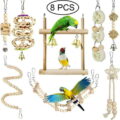


Pingback: 10 Essential Tips on Socializing Pets: A Complete Guide for Owners of 2024
Pingback: How to Train a Puppy: Your First Steps to a Well-Behaved Companion of 2024
Чего нельзя делать при синдроме беспокойных ног, частые недоразумения.
Загадочные препараты для синдрома беспокойных ног, какие приемы действенны?
сидеропенический синдром это [url=https://sindrom-vitmaka.ru/]https://sindrom-vitmaka.ru/[/url] .
как вставлять свечи бетадин [url=https://svechi-dlya-zhenshchin.ru/]как вставлять свечи бетадин[/url] .